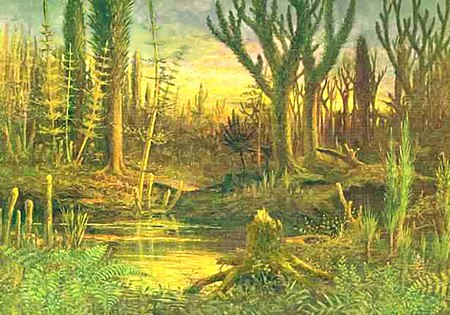User:Abyssal/Portal:Devonian
IntroductionThe Devonian (/dəˈvoʊni.ən, dɛ-/ də-VOH-nee-ən, deh-) is a geologic period and system of the Paleozoic era during the Phanerozoic eon, spanning 60.3 million years from the end of the preceding Silurian period at 419.2 million years ago (Ma), to the beginning of the succeeding Carboniferous period at 358.9 Ma. It is named after Devon, South West England, where rocks from this period were first studied. The first significant evolutionary radiation of life on land occurred during the Devonian, as free-sporing land plants (pteridophytes) began to spread across dry land, forming extensive coal forests which covered the continents. By the middle of the Devonian, several groups of vascular plants had evolved leaves and true roots, and by the end of the period the first seed-bearing plants (pteridospermatophytes) appeared. This rapid evolution and colonization process, which had begun during the Silurian, is known as the Silurian-Devonian Terrestrial Revolution. The earliest land animals, predominantly arthropods such as myriapods, arachnids and hexapods, also became well-established early in this period, after beginning their colonization of land at least from the Ordovician period. (Full article...) Selected article on the Devonian world and its legacies
Arthropods are members of the phylum Arthropoda, and include the insects, arachnids, and crustaceans. They are characterized by their jointed limbs and cuticles. The rigid cuticle inhibits growth, so arthropods replace it periodically by moulting. The arthropod body plan consists of repeated segments, each with a pair of appendages. Their versatility has enabled them to become the most species-rich members of all ecological guilds in most environments. They have over a million described species, making up more than 80% of all described living animal species. They range in size from microscopic plankton up to forms a few meters long.
Like their exteriors, the internal organs of arthropods are generally built of repeated segments. Their vision relies on various combinations of compound eyes and pigment-pit ocelli. Arthropods also have a wide range of chemical and mechanical sensors, mostly based on modifications of the many setae (bristles) that project through their cuticles. Nearly all arthropods lay eggs. Arthropod hatchlings vary from miniature adults to grubs and caterpillars that lack jointed limbs and eventually undergo a total metamorphosis to produce the adult form. The evolutionary ancestry of arthropods dates back to the Cambrian period. The group is generally regarded as monophyletic, and many analyses support the placement of arthropods with cycloneuralians (or their constituent clades) in a superphylum Ecdysozoa. Overall however, the basal relationships of Metazoa are not yet well resolved. Likewise, the relationships between various arthropod groups are still actively debated. (see more...) Did you know?
Need help?Do you have a question about Abyssal/Portal:Devonian that you can't find the answer to? Consider asking it at the Wikipedia reference desk. Selected image
Selected article on the Devonian in human science, culture and economics
Oil shale geology is a branch of geologic sciences which studies the formation and composition of oil shales–fine-grained sedimentary rocks containing significant amounts of kerogen, and belonging to the group of sapropel fuels. Oil shale formation takes place in a number of depositional settings and has considerable compositional variation. Oil shales can be classified by their composition (carbonate minerals such as calcite or detrital minerals such as quartz and clays) or by their depositional environment (large lakes, shallow marine, and lagoon/small lake settings). Much of the organic matter in oil shale is of algal origin, but may also include remains of vascular land plants. Three major type of organic matter (macerals) in oil shale are telalginite, lamalginite, and bituminite. Some oil-shale deposits also contain metals which include vanadium, zinc, copper, uranium.
Most oil shale deposits were formed during Middle Cambrian, Early and Middle Ordovician, Late Devonian, Late Jurassic, and Paleogene times through burial by sedimentary loading on top of the algal swamp deposits, resulting in conversion of the organic matter to kerogen by diagenetic processes. The largest deposits are found in the remains of large lakes such as the deposits of the Green River Formation of Wyoming and Utah, USA. Oil-shale deposits formed in the shallow seas of continental shelves generally are much thinner than large lake basin deposits. (see more...) GeochronologyEpochs - Early Devonian - Middle Devonian - Late Devonian Landmasses - Baltica - Laurentia - Euramerica - Gondwana Fossil sites - Grenfell fossil site History - The Great Devonian Controversy SubcategoriesQuality ContentFeatured Devonian articles - None Things you can doRelated contentAssociated WikimediaThe following Wikimedia Foundation sister projects provide more on this subject:
|






















